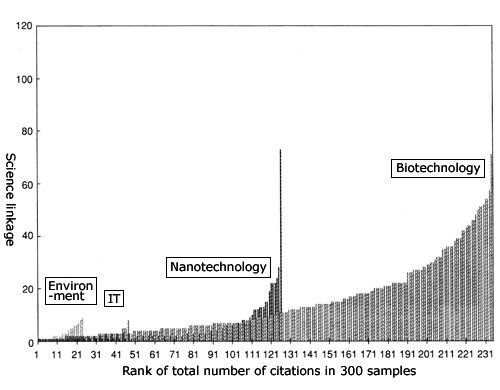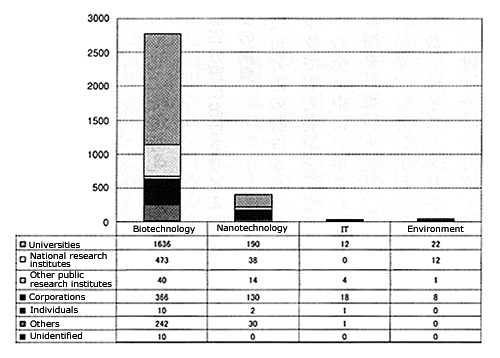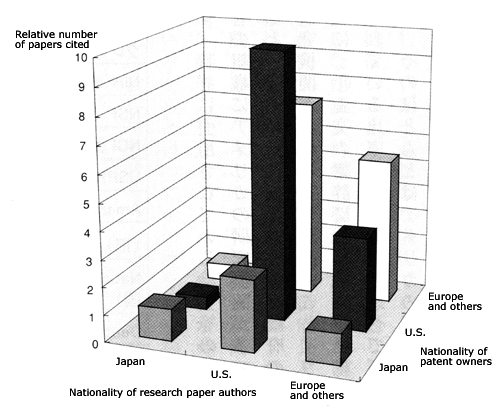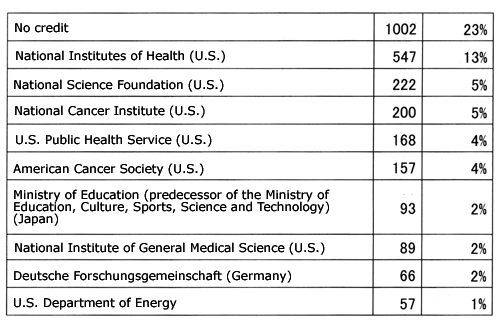Purpose of this study
It has now become clear that technological change, as well as the input of labor and capital, is an important contributing factor to long-term growth (Solow 1956). Scientific research at universities and other research institutes, in turn, has been cited as one of the important factors behind such technological change (Mansfield 1991). Government support for scientific research is justified primarily for these reasons.
To verify the relationship between government support for science and technological change in industry, Narin et al. studied citations of research papers (science linkage) in U.S. patents. Analyzing an enormous volume of data, they showed empirically that scientific linkage has grown in the U.S. over time, with research institutes playing an increasingly important role. Narin and his colleagues found that 73% of the scientific papers cited in U.S. patents are based on science authored at public academic, governmental, and other institutions. They also showed that inventors cite their own country's scientific papers two to four times more often than might be expected from the proportion of such papers published in major scientific citation databases. In particular, they noted the proportion of patented technologies relying on American scientific papers is rapidly increasing. According to Narin et al., U.S. papers cited in patents are characteristically from the mainstream of modern science; they are overwhelmingly basic research, they come from top universities and governmental research institutions, they have been published in the most influential journals and they are heavily supported by the NSF (National Science Foundation) the NIH (National Institutes of Health), or other public agencies (Narin et al., 1997).
In Japan, too, the relationship between technological change and science is important. To date, however, very few studies have been done on Japanese patents. Thus, in this study, our team examined scientific papers cited in Japanese patents. We obtained as many of these papers as possible and identified the nationality and affiliation of institutions undertaking the types of research that are influential in the granting of Japanese patents. We also examined the acknowledgements of cited research papers to determine which agencies in which countries have financed such research.
The purpose of this study is to determine quantitatively how scientific research and the relevant support for it have influenced the process of knowledge creation that has led to the development of patented technologies, in order to provide basic quantitative data for the formulation of an industrial technology policy.
Science linkages in four priority technology areas
(1) Patents in the four priority technology areas and their nationalities
Our first step was to develop a database of Japanese patents. Out of some 65,000 inventions that have been recognized as patentable, entered in the patent register, and published in the patent gazette during the five years from 1995 to 1999, we extracted those dealing with biotechnology, nanotechnology, information technology (IT) and environmental technology, which have been designated as priority technologies under the government's Second Science and Technology Basic Plan.
We examined the nationality of the owners of the 300 sample patents in each of the four priority areas. We found that 150 biotechnology patents, or 50% of the sample, are owned by institutions located outside Japan. Likewise, 86 nanotechnology patents (28%), 43 IT patents (14%) and 36 environmental patents (12%) belong to foreign institutions. Many of foreign patent owners are American institutions.
It is noteworthy is that the foreign ownership ratio is particularly high in the areas of biotechnology and nanotechnology. Half of the biotechnology patents and roughly 30% of the nanotechnology patents in the sample are owned by foreign nationals, as compared to an average foreign ownership of 10% for all patents obtained in Japan.
What accounts for the high percentage of patent applications from overseas in the areas of biotechnology and nanotechnology? Companies apply for patents on technologies because they want exclusive use of these technologies in the countries where they file a patent application. In order for a technology to be recognized as patentable, it must be both novel and practical. Thus, a higher than average percentage of foreign ownership of Japan-granted patents in particular technologies indicates that foreign companies hold a technological advantage in the Japanese market with respect to those specific technologies. The fact that 50% of biotechnology patents granted in Japan and some 30% of nanotechnology patents have been granted to foreign companies shows that foreign companies (particularly American companies) have a technological advantage in these areas.
(2) Science linkages in the four priority areas
We examined the entire text of the sample patents (300 patents in each of the four areas) and counted the number of academic papers cited, all by visual observation.
We found that biotechnology patents have the largest number of citations (science linkage), followed by those in the nanotechnology, IT and environmental areas, in that order. In the area of biotechnology, a maximum of 111 citations were found per patent, while the average and median number of citations were 11.5 and 6 respectively, with a standard deviation of 14.6. With respect to patents in the nanotechnology area, the largest number of citations per patent was 73; 2.0 on average, 0 at the mean, with a standard deviation of 5.8. As to IT patents, the maximum number of citation per patent was 8; 0.32 on average, 0 at the mean, with a standard deviation of 0.92. In the environmental area, the number of citations was 9 at the maximum; 0.l26 on average, 0 at the mean, with a standard deviation of 1.1. (see Figure 1).
Figure 1: Number of citations per patent by technology area and by rank (excluding those without citations)

Academic papers cited in patents
Next, we collected as many academic papers cited in patents for technologies in the four priority areas as possible. Specifically, we tried to collect those papers cited in the sample patents for our analysis, using the ScienceDirect database of scientific literature, to which the University of Tokyo subscribes, as well as the collection of volumes at the University of Tokyo libraries. More than 4,000 titles were thus collected and analyzed.
(1) Nationality of cited academic papers
Based on the address of the organizations to which the authors of these scientific papers are affiliated, we determined the probable country in which underlying research activities took place (hereinafter referred to as the "nationality of papers").
In the biotechnology area, which demonstrates the greatest degree of science linkage, we examined the distribution of nationality with respect to some 2,800 papers, for which we were able to identify the address of the authorsf research institutions. We found more than half of the cited papers were authored by scholars at U.S.-based institutions, while those authored by researchers affiliated with Japanese institutions, the second largest group, accounted for only 9%, followed by Britain at 8%, and Germany at 4%. These results suggest that some 60% of biotechnology patent applications filed in Japan are attributable to knowledge derived from science papers based on research conducted in the U.S. Meanwhile, those based on research activities at universities and national research institutes accounted for 78% of the papers collected for this study, while those based on corporate research represented only 13% (see Figure 2).
Figure 2: Type of institutions with which authoring researchers are affiliated

Likewise, of some 400 papers cited in nanotechnology patents, those based on research conducted at American institutes accounted for 58% of the total, a share equivalent to that for biotechnology patents, followed by papers based on research at Japanese (22%), British (6%), and French (4%) institutes. Although it is generally believed that Japan's nanotechnology is among the most advanced in the world, the nationality distribution of scientific papers cited in patents suggests that inventions in the area of nanotechnology, as with biotechnology inventions, are very dependant on scientific knowledge developed in the U.S. At the same time, however, it should be noted that the percentage of Japanese papers cited in nanotechnology patents is more than twice as high as that of biotechnology patents. This shows that Japanese research achievements in nanotechnology have a greater influence on patents, compared to those in biotechnology. Papers authored by researchers affiliated with universities and public research institutes accounted for 59% of the papers cited in the nanotechnology field, while those written by corporate researchers comprised 33% of the total.
In the IT area, Japan topped the nationality ranking, with 14 papers cited in patents, accounting for 39%. The U.S. had 13 papers, or 37%, followed by Germany with 3 papers, or 9%. It should be noted that only 35 papers cited among the 300 IT sample patents were identified by nationality, which is roughly one-eightieth the number cited in biotechnology patents, and less than one-tenth the number cited in nanotechnology patents. We must therefore be cautious about comparing the foreign ownership ratio of IT patents with those of biotechnology and nanotechnology. But if we venture to analyze the implications of these figures, we can probably say that the number of Japanese papers cited in IT patents slightly exceeds the number of American papers, and that research activities in the two countries are almost equal in their impact on IT patents. Papers authored by corporate researchers accounted for 50% of research papers cited in IT patents, exceeding the 44% written by researchers at universities and public research institutes. This indicates that corporate R&D activities are quite robust in the IT area.
We should also be cautious in analyzing the situation in environmental technology, where we found only 43 papers whose nationality was indicated cited in patents. Of these, 16 papers or 38% were Japanese, 11 papers or 26% were American, four papers or 9% were British, and three papers or 7% were German. This may suggest that nearly 40% of the scientific research that has influenced the development of patented environmental technologies was conducted in Japan, and that Japan has surpassed the U.S. in the area of environment-related research. Papers authored by researchers affiliated with universities and public research institutes represent 81% of research papers cited in environmental technology patents, with the remaining 19% written by corporate researchers. Such heavy reliance on academic and public-sector research may be characteristic of this particular field of technology.
(2) Cross-analysis of the nationality of biotechnology patent holders and the nationality of underlying research papers (see Figure 3)
The likely counterargument to the preceding analysis is that the large number of American papers are cited in biotechnology patents is due simply to the large number of patent applications from the U.S. and these applications tend to cite American papers. To examine this point, we looked more closely at patents in the field of biotechnology, an area with a particularly large number of applications from overseas. Specifically, we divided the sample patents in the biotechnology area into three groups by nationality of applicants (i.e., patents applied for by Japanese nationals, including Japanese corporations); patents applied for by U.S. nationals (under the same conditions); and patents applied for by European and other nationals (also under the same conditions). We then examined the distribution of nationalities of the cited papers for each group. Out of a total of 735 papers cited in 150 sample biotechnology patents applied for by Japanese nationals, 53% were authored by researchers affiliated with American research institutes, followed by Japanese research institutes at 25%, and European and others at 23%. Likewise, out of a total of 1,140 papers cited in 83 patents applied for by U.S. nationals, 72% were authored by researchers affiliated with American institutions, followed by European and other institutions at 25%, and Japanese institutions at 3%. Patents applied for by European and other nationals totaled 43, in which 891 papers were cited. Here again, papers authored by researchers at American institutions accounted for 55% of all cited papers, followed by papers authored by researchers at European and other institutions at 40%, and papers authored by researchers at Japanese institutions accounting for 5% of the total.
Figure 3: Cross-analysis of the nationality of biotechnology patent owners and the nationality of underlying research papers

What stands out in the biotechnology patents is the fact that American papers account for the largest portion of cited papers regardless of the nationality of patent applicants. It is generally believed that, given the costs of knowledge transfer including the cost of travel and the cost of overcoming language barriers, patent applicants tend to cite papers originating from areas that are geographically close or from areas where their own language is spoken. Indeed, this trend has been verified in a previous study (Narin et al., 1997). Despite this, however, our research has found that a disproportionately large number of American papers are cited in biotechnology patents regardless of the nationality of the patent holder. This can be taken as an indication that the U.S. generates biotechnology-related knowledge to the extent that its influence over biotechnology patents more than offsets what Narin calls a "strong national component" in the rest of the world.
(3) Agencies credited with supporting biotechnology research (see Table 1)
What are the reasons for the citation of American papers in biotechnology patents? To answer this question, we read the acknowledgements of the cited papers and extracted words of thanks, phrases such as, "This research was supported by...," for each area of technology.
Table 1: Support agencies acknowledged in biotechnology papers

Of some 4,300 papers cited in biotechnology patents, 76% explicitly refer to an organization that has provided support for the underlying research. This percentage is considerably higher than the 42% for nanotechnology, the 31% for IT, and the 43% for environmental technology. Another noteworthy feature of biotechnology-related research is that most of the supporting agencies are located in the U.S.
Observation
Based on the above, we found that the biotechnology area -- which shows a conspicuously strong science linkage -- is distinctive in the following four ways:
- About 50% of biotechnology patents are owned by companies outside Japan, with 30% held by those based in the U.S., and the overall foreign ownership ratio is substantially higher than those for patents in other technology areas;
- Regardless the nationality of patent owners, many authoring researchers of cited papers are affiliated with research institutes in the U.S.;
- Many of these institutes are university- or government-affiliated research institutes; and
- Papers cited in biotechnology patents, as compared to those related to technologies in the other areas, have a greater tendency to explicitly acknowledge supporting agencies.
The first finding, which is indicative of a country's technological competitiveness in the global market in terms of patents, shows that foreign companies, particularly those in the U.S., have a competitive advantage in the area of biotechnology. The second finding shows that the U.S. has a competitive advantage in basic research and that European and Japanese companies are receiving spillover benefits from basic research done in the U.S. The third and fourth findings quantitatively verify that biotechnology-related science research activities, which provide the basis for patented technologies, are primarily undertaken by universities and governmental research institutes, and that these research activities receive massive support from the NIH and other government agencies in the U.S.
In other words, at least in the area of biotechnology, findings from research undertaken by U.S.-based universities primarily with support of U.S. public funds are announced in the form of research papers, which become the source of new patentable technologies. The results of this publicly funded research not only enhance American companies' competitiveness in the area of biotechnology, but also become public goods that spill over to Europe and Japan, where they are utilized to develop patented technologies.
Some argue as if Japanese scientific research has reached an internationally competitive level simply because Japanese researchers were awarded the Nobel Prize in chemistry for three years in row from 2000 and 2002. However, Japan has so far produced only eight Nobel Prize winners in chemistry and physics, which is no match for some 200 in the U.S. or the roughly 70 in Britain. Furthermore, many of the Japanese Nobel Prize winners have studied overseas or won their prize for research done outside Japan. Based on the definitions used in this study, their research papers - which are for research undertaken overseas and supported by foreign funds and foreign research systems - are categorized as research papers of foreign nationality, regardless of whether they were authored by Japanese nationals.
Active discussions are now taking place on the formulation of the Third Science and Technology Basic Plan. One often hears such terms as "research expenditure bubble," while some call for the curtailment of government expenditures on science research, pointing to ongoing fiscal difficulties. However, as discussed above, the findings from our quantitative study of science linkage point to the fact that Japanese scientific research, particularly in terms of scientific knowledge in biotechnology, is severely deficient. That is, Japan has a huge deficit in "knowledge trade." This shows the vulnerability of Japan's scientific research stock. It is far from adequate for the government to secure scientific research funding equivalent to 1% of GDP for only 10 years or so. Needless to say, Japan is an archipelago that is poor in natural resources and has a very small land area. Improving the national capacity for production of highly sophisticated, knowledge-intensive products through constant efforts to reinforce scientific and technological capabilities is one of the few ways to sustain Japan's economic growth and enable its people to lead affluent lives. Cutting back on efforts to become a science and technology powerhouse at this point of time is nothing but an attempt at commit a national suicide or tantamount to killing the goose that lays the golden eggs.


